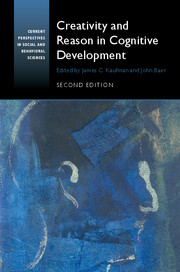Book contents
- Frontmatter
- Dedication
- Contents
- List of Contributors
- Acknowledgments
- 1 Creativity, Reason and Cognitive Development: Ten Years Later
- SECTION ONE CREATIVITY AND REASON IN CHILDHOOD AND THE SCHOOLS
- 2 Creativity in Young Children's Thought
- 3 Early Experiences and Creativity: An Ecological Perspective
- 4 Imaginative Play
- 5 Revisiting the Relationship among Schooling, Learning, and Creativity
- 6 Higher Level Thinking in Gifted Education
- 7 A Young Artist's Story: Advancing Knowledge and the Development of Artistic Talent and Creativity in Children
- SECTION TWO CREATIVITY AND REASON IN COGNITION AND NEUROSCIENCE
- SECTION THREE CREATIVITY AND REASON: INTERACTIONS AND RELATED CONSTRUCTS
- Author Index
- Subject Index
- References
6 - Higher Level Thinking in Gifted Education
from SECTION ONE - CREATIVITY AND REASON IN CHILDHOOD AND THE SCHOOLS
Published online by Cambridge University Press: 05 February 2016
- Frontmatter
- Dedication
- Contents
- List of Contributors
- Acknowledgments
- 1 Creativity, Reason and Cognitive Development: Ten Years Later
- SECTION ONE CREATIVITY AND REASON IN CHILDHOOD AND THE SCHOOLS
- 2 Creativity in Young Children's Thought
- 3 Early Experiences and Creativity: An Ecological Perspective
- 4 Imaginative Play
- 5 Revisiting the Relationship among Schooling, Learning, and Creativity
- 6 Higher Level Thinking in Gifted Education
- 7 A Young Artist's Story: Advancing Knowledge and the Development of Artistic Talent and Creativity in Children
- SECTION TWO CREATIVITY AND REASON IN COGNITION AND NEUROSCIENCE
- SECTION THREE CREATIVITY AND REASON: INTERACTIONS AND RELATED CONSTRUCTS
- Author Index
- Subject Index
- References
Summary
Over the past several decades, studies have continued to suggest the relationship between critical thinking and reasoning to high-level creative production within and across domains (Csikszentmihalyi, 2000; Gardner, 2000). Becoming a creative producer or innovator in the real world is predicated on the acquisition of a combination of creative thinking, problem-solving, and critical thinking abilities within a domain.
While earlier studies have shown that students show important gains in content-specific higher order skills such as literary analysis and persuasive writing in language arts (VanTassel-Baska et al., 2002) or designing experiments in science (VanTassel-Baska et al., 1998), studies have only recently demonstrated that a content-based intervention provided students with enhanced generic critical thinking and reasoning skills at the elementary level (Bracken et al., 2003; VanTassel-Baska, Bracken, Feng & Brown, 2009).
Most K–12 programs for gifted students include some components of critical thinking as a fundamental part of the curriculum (Chandler, 2004). We have now begun to test the efficacy of curriculum in respect to student growth in this area at various stages of development rather than being satisfied to use proxy outcome data such as Advanced Placement (AP) and International Baccalaureate (IB) scores, Scholastic Aptitude Test (SAT) scores, or even state tests to tell us how well these students are performing at higher levels of thought (VanTassel-Baska & Feng, 2003). The new Common Core State Standards (CCSS), adopted in forty-six states, provide a template for using critical thinking skills within both language arts and mathematics. As new assessments emerge that are more performance based and require evidence of higher level thinking, the opportunity for the infusion of these skills in the core curriculum may be ensured. There still remains, however, a need for the gifted community to be concerned about the use of these standards with gifted learners with respect to how they are translated and the flexibility of implementation in allowing some of these standards to be satisfied at earlier stages of development.
The teaching of creativity, however, is not as prevalent in classrooms owing to the stronger emphasis on standards and accountability, measures that stress critical thinking to the exclusion of creative thinking skills. Still, some evidence suggests that educational programs based on appreciation for creative thinking abilities may in fact facilitate the creativity process in learners over time.
- Type
- Chapter
- Information
- Creativity and Reason in Cognitive Development , pp. 92 - 113Publisher: Cambridge University PressPrint publication year: 2016
References
- 1
- Cited by



